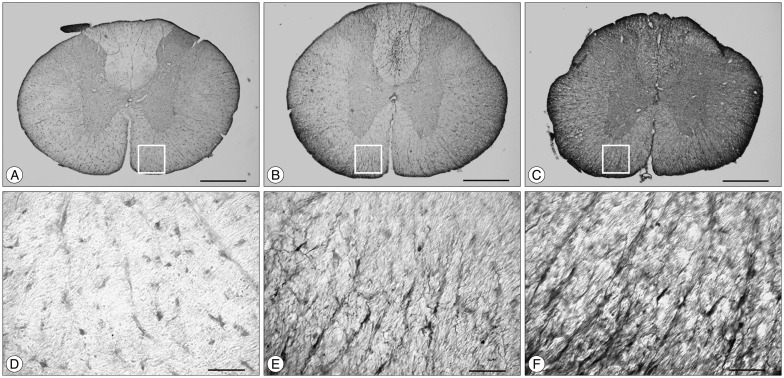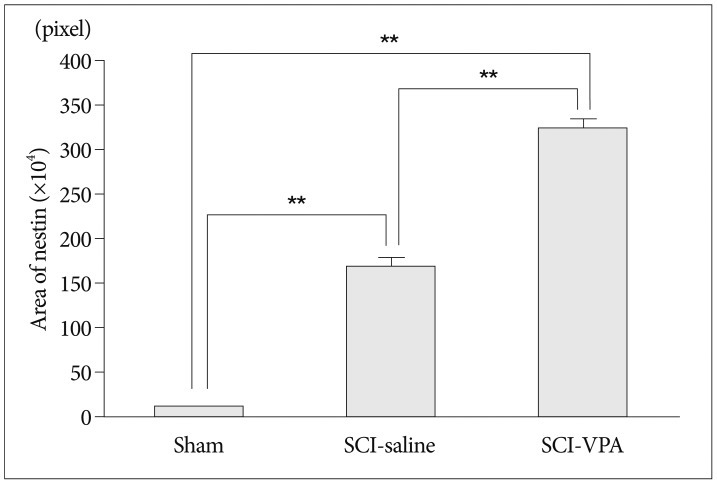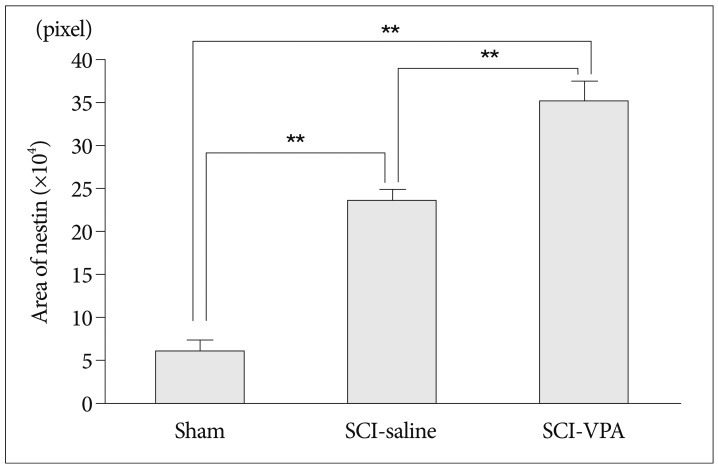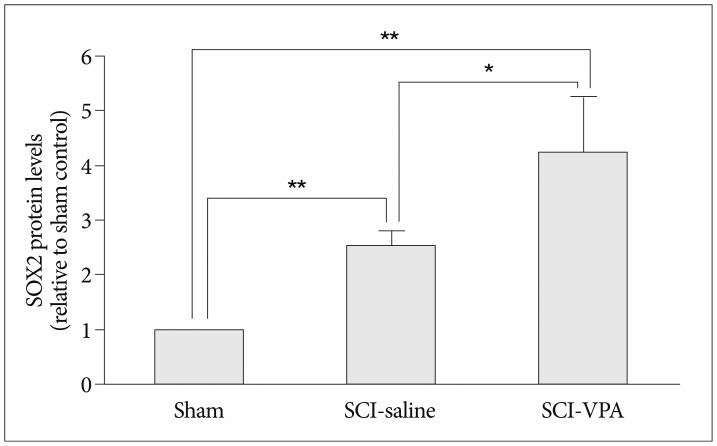J Korean Neurosurg Soc.
2013 Jul;54(1):8-13. 10.3340/jkns.2013.54.1.8.
Valproic Acid Increases Expression of Neuronal Stem/Progenitor Cell in Spinal Cord Injury
- Affiliations
-
- 1Department of Neurosurgery, Kyungpook National University Hospital, Daegu, Korea. nskimkt7@gmail.com
- KMID: 2190850
- DOI: http://doi.org/10.3340/jkns.2013.54.1.8
Abstract
OBJECTIVE
This study investigates the effect of valproic acid (VPA) on expression of neural stem/progenitor cells (NSPCs) in a rat spinal cord injury (SCI) model.
METHODS
Adult male rats (n=24) were randomly and blindly allocated into three groups. Laminectomy at T9 was performed in all three groups. In group 1 (sham), only laminectomy was performed. In group 2 (SCI-VPA), the animals received a dose of 200 mg/kg of VPA. In group 3 (SCI-saline), animals received 1.0 mL of the saline vehicle solution. A modified aneurysm clip with a closing force of 30 grams was applied extradurally around the spinal cord at T9, and then rapidly released with cord compression persisting for 2 minutes. The rats were sacrificed and the spinal cord were collected one week after SCI. Immunohistochemistry (IHC) and western blotting sample were obtained from 5 mm rostral region to the lesion and prepared. We analyzed the nestin immunoreactivity from the white matter of ventral cord and the ependyma of central canal. Nestin and SOX2 were used for markers for NSPCs and analyzed by IHC and western blotting, respectively.
RESULTS
Nestin and SOX2 were expressed significantly in the SCI groups but not in the sham group. Comparing SCI groups, nestin and SOX2 expression were much stronger in SCI-VPA group than in SCI-saline group.
CONCLUSION
Nestin and SOX2 as markers for NSPCs showed increased expression in SCI-VPA group in comparison with SCI-saline group. This result suggests VPA increases expression of spinal NSPCs in SCI.
MeSH Terms
Figure
Cited by 1 articles
-
Review of the UBC Porcine Model of Traumatic Spinal Cord Injury
Kyoung-Tae Kim, Femke Streijger, Neda Manouchehri, Kitty So, Katelyn Shortt, Elena B. Okon, Seth Tigchelaar, Peter Cripton, Brian K. Kwon
J Korean Neurosurg Soc. 2018;61(5):539-547. doi: 10.3340/jkns.2017.0276.
Reference
-
1. Balentine JD. Pathology of experimental spinal cord trauma. I. The necrotic lesion as a function of vascular injury. Lab Invest. 1978; 39:236–253. PMID: 713489.2. Balentine JD. Pathology of experimental spinal cord trauma. II. Ultrastructure of axons and myelin. Lab Invest. 1978; 39:254–266. PMID: 713490.3. Basso DM, Beattie MS, Bresnahan JC. Graded histological and locomotor outcomes after spinal cord contusion using the NYU weight-drop device versus transection. Exp Neurol. 1996; 139:244–256. PMID: 8654527.
Article4. Brederlau A, Correia AS, Anisimov SV, Elmi M, Paul G, Roybon L, et al. Transplantation of human embryonic stem cell-derived cells to a rat model of Parkinson's disease : effect of in vitro differentiation on graft survival and teratoma formation. Stem Cells. 2006; 24:1433–1440. PMID: 16556709.
Article5. Brüstle O, Jones KN, Learish RD, Karram K, Choudhary K, Wiestler OD, et al. Embryonic stem cell-derived glial precursors : a source of myelinating transplants. Science. 1999; 285:754–756. PMID: 10427001.
Article6. Bug G, Gül H, Schwarz K, Pfeifer H, Kampfmann M, Zheng X, et al. Valproic acid stimulates proliferation and self-renewal of hematopoietic stem cells. Cancer Res. 2005; 65:2537–2541. PMID: 15805245.
Article7. Chen PS, Peng GS, Li G, Yang S, Wu X, Wang CC, et al. Valproate protects dopaminergic neurons in midbrain neuron/glia cultures by stimulating the release of neurotrophic factors from astrocytes. Mol Psychiatry. 2006; 11:1116–1125. PMID: 16969367.
Article8. Chuang DM, Leng Y, Marinova Z, Kim HJ, Chiu CT. Multiple roles of HDAC inhibition in neurodegenerative conditions. Trends Neurosci. 2009; 32:591–601. PMID: 19775759.
Article9. Dash PK, Orsi SA, Zhang M, Grill RJ, Pati S, Zhao J, et al. Valproate administered after traumatic brain injury provides neuroprotection and improves cognitive function in rats. PLoS One. 2010; 5:e11383. PMID: 20614021.
Article10. Feng HL, Leng Y, Ma CH, Zhang J, Ren M, Chuang DM. Combined lithium and valproate treatment delays disease onset, reduces neurological deficits and prolongs survival in an amyotrophic lateral sclerosis mouse model. Neuroscience. 2008; 155:567–572. PMID: 18640245.
Article11. Gage FH, Coates PW, Palmer TD, Kuhn HG, Fisher LJ, Suhonen JO, et al. Survival and differentiation of adult neuronal progenitor cells transplanted to the adult brain. Proc Natl Acad Sci U S A. 1995; 92:11879–11883. PMID: 8524867.
Article12. Go HS, Kim KC, Choi CS, Jeon SJ, Kwon KJ, Han SH, et al. Prenatal exposure to valproic acid increases the neural progenitor cell pool and induces macrocephaly in rat brain via a mechanism involving the GSK-3β/β-catenin pathway. Neuropharmacology. 2012; 63:1028–1041. PMID: 22841957.
Article13. Gorio A, Gokmen N, Erbayraktar S, Yilmaz O, Madaschi L, Cichetti C, et al. Recombinant human erythropoietin counteracts secondary injury and markedly enhances neurological recovery from experimental spinal cord trauma. Proc Natl Acad Sci U S A. 2002; 99:9450–9455. PMID: 12082184.
Article14. Imitola J, Raddassi K, Park KI, Mueller FJ, Nieto M, Teng YD, et al. Directed migration of neural stem cells to sites of CNS injury by the stromal cell-derived factor 1alpha/CXC chemokine receptor 4 pathway. Proc Natl Acad Sci U S A. 2004; 101:18117–18122. PMID: 15608062.
Article15. Inoue T, Kawaguchi S, Kurisu K. Spontaneous regeneration of the pyramidal tract after transection in young rats. Neurosci Lett. 1998; 247:151–154. PMID: 9655615.
Article16. Iseda T, Nishio T, Kawaguchi S, Yamanoto M, Kawasaki T, Wakisaka S. Spontaneous regeneration of the corticospinal tract after transection in young rats : a key role of reactive astrocytes in making favorable and unfavorable conditions for regeneration. Neuroscience. 2004; 126:365–374. PMID: 15207354.
Article17. Johansson CB, Momma S, Clarke DL, Risling M, Lendahl U, Frisén J. Identification of a neural stem cell in the adult mammalian central nervous system. Cell. 1999; 96:25–34. PMID: 9989494.
Article18. Keirstead HS, Nistor G, Bernal G, Totoiu M, Cloutier F, Sharp K, et al. Human embryonic stem cell-derived oligodendrocyte progenitor cell transplants remyelinate and restore locomotion after spinal cord injury. J Neurosci. 2005; 25:4694–4705. PMID: 15888645.
Article19. Kikukawa S, Kawaguchi S, Mizoguchi A, Ide C, Koshinaga M. Regeneration of dorsal column axons after spinal cord injury in young rats. Neurosci Lett. 1998; 249:135–138. PMID: 9682835.
Article20. Kim HJ, Rowe M, Ren M, Hong JS, Chen PS, Chuang DM. Histone deacetylase inhibitors exhibit anti-inflammatory and neuroprotective effects in a rat permanent ischemic model of stroke : multiple mechanisms of action. J Pharmacol Exp Ther. 2007; 321:892–901. PMID: 17371805.
Article21. Lee H, Shamy GA, Elkabetz Y, Schofield CM, Harrsion NL, Panagiotakos G, et al. Directed differentiation and transplantation of human embryonic stem cell-derived motoneurons. Stem Cells. 2007; 25:1931–1939. PMID: 17478583.
Article22. Lee HJ, Wu J, Chung J, Wrathall JR. SOX2 expression is upregulated in adult spinal cord after contusion injury in both oligodendrocyte lineage and ependymal cells. J Neurosci Res. 2013; 91:196–210. PMID: 23169458.
Article23. Lee SM, Yune TY, Kim SJ, Park DW, Lee YK, Kim YC, et al. Minocycline reduces cell death and improves functional recovery after traumatic spinal cord injury in the rat. J Neurotrauma. 2003; 20:1017–1027. PMID: 14588118.
Article24. Li S, Strittmatter SM. Delayed systemic Nogo-66 receptor antagonist promotes recovery from spinal cord injury. J Neurosci. 2003; 23:4219–4227. PMID: 12764110.
Article25. Maurer MH, Brömme JO, Feldmann RE Jr, Järve A, Sabouri F, Bürgers HF, et al. Glycogen synthase kinase 3beta (GSK3beta) regulates differentiation and proliferation in neural stem cells from the rat subventricular zone. J Proteome Res. 2007; 6:1198–1208. PMID: 17330951.
Article26. Nistor GI, Totoiu MO, Haque N, Carpenter MK, Keirstead HS. Human embryonic stem cells differentiate into oligodendrocytes in high purity and myelinate after spinal cord transplantation. Glia. 2005; 49:385–396. PMID: 15538751.
Article27. Qing H, He G, Ly PT, Fox CJ, Staufenbiel M, Cai F, et al. Valproic acid inhibits Abeta production, neuritic plaque formation, and behavioral deficits in Alzheimer's disease mouse models. J Exp Med. 2008; 205:2781–2789. PMID: 18955571.
Article28. Ren M, Leng Y, Jeong M, Leeds PR, Chuang DM. Valproic acid reduces brain damage induced by transient focal cerebral ischemia in rats : potential roles of histone deacetylase inhibition and heat shock protein induction. J Neurochem. 2004; 89:1358–1367. PMID: 15189338.
Article29. Rowland JW, Hawryluk GW, Kwon B, Fehlings MG. Current status of acute spinal cord injury pathophysiology and emerging therapies : promise on the horizon. Neurosurg Focus. 2008; 25:E2. PMID: 18980476.30. Shibuya S, Miyamoto O, Auer RN, Itano T, Mori S, Norimatsu H. Embryonic intermediate filament, nestin, expression following traumatic spinal cord injury in adult rats. Neuroscience. 2002; 114:905–916. PMID: 12379246.
Article31. Sinn DI, Kim SJ, Chu K, Jung KH, Lee ST, Song EC, et al. Valproic acid-mediated neuroprotection in intracerebral hemorrhage via histone deacetylase inhibition and transcriptional activation. Neurobiol Dis. 2007; 26:464–472. PMID: 17398106.
Article32. Sugai F, Yamamoto Y, Miyaguchi K, Zhou Z, Sumi H, Hamasaki T, et al. Benefit of valproic acid in suppressing disease progression of ALS model mice. Eur J Neurosci. 2004; 20:3179–3183. PMID: 15579172.
Article33. Sumner CJ, Huynh TN, Markowitz JA, Perhac JS, Hill B, Coovert DD, et al. Valproic acid increases SMN levels in spinal muscular atrophy patient cells. Ann Neurol. 2003; 54:647–654. PMID: 14595654.
Article
- Full Text Links
- Actions
-
Cited
- CITED
-
- Close
- Share
- Similar articles
-
- Combined Method of Neuronal Cell-Inducible Vector and Valproic Acid for Enhanced Gene Expression under Hypoxic Conditions
- Current Concept and Future of the Management of Spinal Cord Injury: A Systematic Review
- Fate of Transplanted Bone Marrow Derived Mesenchymal Stem Cells Following Spinal Cord Injury in Rats by Transplantation Routes
- Epigenetically Upregulated T-Type Calcium Channels Contribute to Abnormal Proliferation of Embryonic Neural Progenitor Cells Exposed to Valproic Acid
- Current Concept of Stem Cell Therapy for Spinal Cord Injury: A Review







